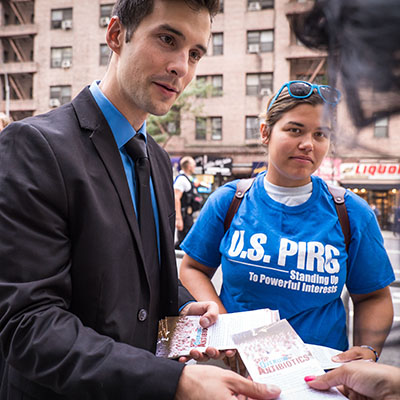
Matt Wellington
Former Director, Public Health Campaigns, PIRG
Today, the Oversight Subcommittee of the Energy and Commerce Committee -- the very Committee that dramatically and finally exposed tobacco companies’ ploys to deceive smokers back in 1994 -- is taking on the tobacco threat 2.0 with a hearing about the public health risks of e-cigarettes. Subcommittee Chair Diana DeGette (D-CO) submitted U.S. PIRG's blog on the youth vaping epidemic into the official record of the hearing.
Former Director, Public Health Campaigns, PIRG
Nicotine use was a big part of American culture until the past few decades, when society started holding tobacco companies accountable for the deadly addiction they promoted. But nicotine is back in a big way as the drug of choice for a new generation using a new delivery method — e-cigarettes. Preliminary data from the National Youth Tobacco Survey show that 27.5 percent of high schoolers — more than 1 in 4 — reported vaping in 2019. Another study shows 20 percent of 10th graders reported vaping this year–smoking rates among that age group haven’t been that high in more than twenty years.
Today, the Oversight Subcommittee of the Energy and Commerce Committee — the very Committee that dramatically and finally exposed tobacco companies’ ploys to deceive smokers back in 1994 — is taking on the tobacco threat 2.0 with a hearing about the public health risks of e-cigarettes.
I commend Energy and Commerce Oversight and Investigation Subcommittee Chair, Diana DeGette (D-CO), for bringing this issue back to the attention of this committee, as well as Energy and Commerce Chairman Frank Pallone (D-NJ) for his legislation, “The Reversing the Youth Tobacco Epidemic Act”, which would ban flavored tobacco products among other important steps to reign in youth use. In a rare case where lawmakers on both sides of the aisle agree, legislators are pushing to address this critical health threat. That’s why Rep. Raja Krishnamoorthi (D-IL) and Rep. Peter King (R-NY) launched the new Congressional Caucus to End the Youth Vaping Epidemic.
The latest data from the National Institutes of Health show that vaping rates among teens have doubled since 2017. The U.S. Surgeon General considers e-cigarette use among young people an epidemic. It’s a public health nightmare, threatening to unravel decades of progress to cut youth tobacco use.
This week’s congressional hearings were prompted by an explosion of vaping-related lung illness, with more than 500 cases, and at least seven deaths, being investigated across the country. The Centers for Disease Control and Prevention has yet to identify a direct cause beyond linking the problem to e-cigarette use.
While the mysterious lung illness raging across the country is cause for serious concern, it’s important not to lose sight of the fact that youth e-cigarette use is and always has been unsafe. E-cigarettes almost always contain nicotine, an addictive drug that can impact learning, memory and attention among adolescents. It can also contribute to mood disorders and increase the risk of future addiction to other dangerous substances. Research also suggests that young people using e-cigarettes are more likely than non-users to start smoking combustible cigarettes. An analysis of recent studies shows that young adults who vape are three times more likely than non-users to start smoking cigarettes. Not only is e-cigarette use hooking a generation of kids on nicotine, it’s potentially opening a gateway to cigarette smoking — one of the deadliest habits anyone can have.
There is significant evidence that flavored tobacco products, including e-cigarettes, attract and hook kids. According to a recent analysis by the Food and Drug Administration (FDA), 96 percent of e-cig users aged 12-17 reported that they used a flavored e-cigarette the first time they tried the product, and 70.3 percent of current youth users said that they used e-cigarettes “because they come in flavors I like.” According to the new preliminary National Youth Tobacco Survey data, fruit is the most popular flavor category among high school e-cigarette users, with mint/menthol coming in second.
The FDA is proposing to take flavored e-cigarettes, other than those with tobacco flavor, off the market, pending review. It’s still unclear whether the agency will follow through with that plan, and companies could still sell flavored e-cigarettes in the future if they go through the agency’s review process and receive approval.
Let’s be clear in rebutting the main argument of e-cig manufacturers and marketers: claims that vapes are a safe and effective way for smokers to quit are not supported by conclusive scientific evidence. The FDA has not authorized any e-cigarette company to market their e-cigarettes as smoking cessation devices. In fact, the agency recently sent a warning letter to Juul, the most popular e-cigarette company. The letter told Juul that it’s marketing its products illegally by portraying them as a less harmful alternative to combustible cigarettes, without required authorization from the agency.
Prohibiting the sale of all flavored tobacco products, including those flavored as mint and menthol, will make e-cigarette use, and tobacco use overall, less appealing to young people.
Given the rampant rise in vaping in recent years, it’s critical that lawmakers act now to protect children’s health. History is repeating itself with tobacco use among young people. Let’s make sure to repeat the part where lawmakers and health advocates fight back. Otherwise, millions more kids will get caught in the nicotine trap and derail their health and their futures.
U.S. PIRG is the federation of state Public Interest Research Groups. PIRGs are non-profit, non-partisan public interest advocacy organizations that stand up to powerful interests whenever they threaten our health and safety, our financial security, or our right to fully participate in our democratic society.
Former Director, Public Health Campaigns, PIRG